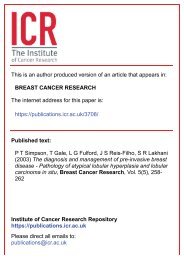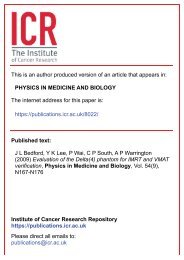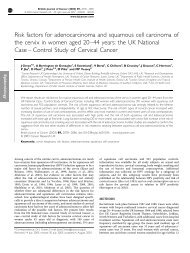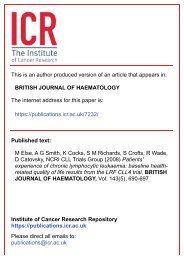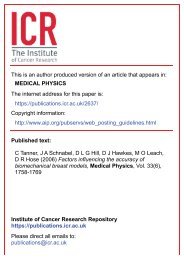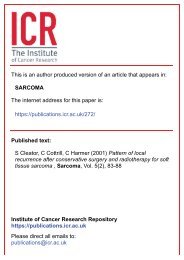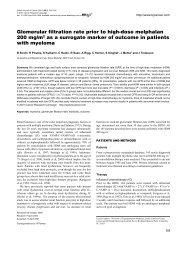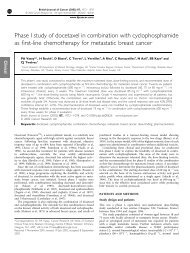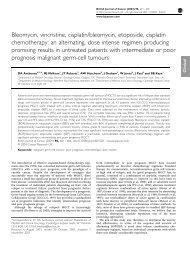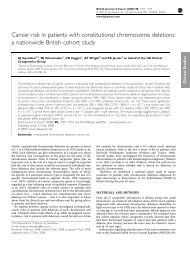Transcriptome analysis of mammary epithelial subpopulations ...
Transcriptome analysis of mammary epithelial subpopulations ...
Transcriptome analysis of mammary epithelial subpopulations ...
You also want an ePaper? Increase the reach of your titles
YUMPU automatically turns print PDFs into web optimized ePapers that Google loves.
BMC Genomics 2008, 9:591http://www.biomedcentral.com/1471-2164/9/591well as genes expressed in subsets <strong>of</strong> its cells. The basal/myo<strong>epithelial</strong> cell population is also a mixed population.However, > 90% <strong>of</strong> these cells express both keratin 14 andα-is<strong>of</strong>orm smooth muscle actin and are thus differentiatedmyo<strong>epithelial</strong> cells [5]. Therefore, the gene expressionpr<strong>of</strong>ile <strong>of</strong> this population is largely a myo<strong>epithelial</strong>cell pr<strong>of</strong>ile. The luminal ER + population is also unlikely torepresent a completely uniform cell population but as themajority <strong>of</strong> the cells are strongly keratin 18 positive andexpress the estrogen receptor [5], the gene expression pr<strong>of</strong>ile<strong>of</strong> this population will be dominated by this single celltype.Myo<strong>epithelial</strong> cells are key regulators <strong>of</strong> paracrinesignalling<strong>Transcriptome</strong> and network interaction <strong>analysis</strong> <strong>of</strong> thebasal/myo<strong>epithelial</strong> cells identified key processes <strong>of</strong> thesecells as cytoskeletal function and extracellular matrix productionand interactions. Given what is known about thecontractile function <strong>of</strong> these cells in lactation and theirposition in the <strong>mammary</strong> gland between the luminal epitheliumand the basement membrane around the ductsand lobulo-alveolar structures, these results were reassuring.However, what was remarkable was that the genescharacteristic <strong>of</strong> this population included more than doublenumber <strong>of</strong> genes for proteins involved in cell – cell signallingthan were characteristic <strong>of</strong> the two luminalpopulations combined. This suggests a key role formyo<strong>epithelial</strong> cells in mediating paracrine and juxtacrinecell – cell interactions in the <strong>mammary</strong> epithelium. Ofparticular interest were the expression patterns <strong>of</strong> Wnt andNotch signalling pathway components, known to beimportant in <strong>mammary</strong> gland development [64,65],which suggested a directionality <strong>of</strong> Notch signalling frombasal to luminal and a directionality <strong>of</strong> Wnt signallingfrom luminal to basal. Notably, Notch signalling wasrecently shown to be important for determining luminalcell fate [19], possibly through regulation <strong>of</strong> luminal progenitors[18]. Activated Wnt signalling has also beenshown to increase the stem/progenitor fraction <strong>of</strong> basal<strong>mammary</strong> <strong>epithelial</strong> cells in MMTV-Wnt1 transgenic mice[3].Another gene from a family important for <strong>mammary</strong>development that, like Notch3, was expressed in both theluminal populations but not the basal/myo<strong>epithelial</strong> cellswas Erbb3. A member <strong>of</strong> the epidermal growth factorreceptor family, Erbb3 most effectively binds the neuregulinsNrg1 and Nrg2, but it has no intrinsic signallingactivity <strong>of</strong> its own. It must therefore operate as a heterodimerwith other family members. However, signallingcomplexes containing Erbb3 have a strong propensity toactivate the phosphoinositide-3-kinase (PI3K) signallingpathway due to the presence <strong>of</strong> six binding sites for thep85 SH3 adaptor subunit <strong>of</strong> PI3K [51]. Erbb3 knockoutanimals were embryonic lethal but reduction <strong>of</strong> Erbb3expression in the <strong>mammary</strong> epithelium caused a reductionin terminal end bud numbers, branching and ductaldensity [51,66]. Previous reports <strong>of</strong> Erbb3 expression havebeen inconsistent [67,68], most likely due to variableantibody quality, however, the ductal outgrowth defectsthat occur when Erbb3 expression is reduced, togetherwith the observation that implantation <strong>of</strong> Nrg1-soakedpellets induced ductal elongation at puberty [69], supporta role for Erbb3 in pubertal <strong>mammary</strong> development.Whether or not Erbb3 activation has the same consequencesin both the luminal ER + and luminal ER - cellsremains to be determined and may depend on differentialexpression <strong>of</strong> dimerisation partners not detected by themicroarray assays.Mammary <strong>epithelial</strong> cell <strong>subpopulations</strong> have distincttranscription factor pr<strong>of</strong>ilesMutual interactions between transcription factors associatedwith different cell lineages and involving positive andnegative feedback loops have been demonstrated to beable to maintain haematopoietic cells in a small number<strong>of</strong> particular cell fates ('stable states') when an apparentlylarge number <strong>of</strong> potential intermediate fates are available[54]. Transcription factors in the <strong>mammary</strong> epitheliumwhich have the potential to interact but which are apparentlyexpressed in different populations are therefore <strong>of</strong>particular interest in the regulation <strong>of</strong> <strong>mammary</strong> <strong>epithelial</strong>cell fate. We built a gene network to predict such interactionsand identified a number <strong>of</strong> these which arepotentially important. The most obvious is between Esr1(luminal ER + ) [56], Trp63 (basal) [70] and Myc (basal andluminal ER - ) [55] and given the large number <strong>of</strong> transcriptiontargets they share, it is likely that these three are keyfactors in determining cell fate in the <strong>mammary</strong> gland.However, there are also other interacting factors <strong>of</strong> interestsuch as the Runx2 (basal) [71] – Msx2 (luminal ER + ) [72]pair, the Eya2 (basal) – Six4 (luminal ER - ) pair [73] andthe Foxa1 (luminal ER + ) [57] – AR (basal and luminalER + ) [74] – Etv5 (basal) [75] triplet. Modelling these interactionsin order to make predictions about how transcriptionfactor behaviour determines <strong>mammary</strong> cell fate is animportant challenge for the future.Sox6 is a determinant <strong>of</strong> luminal cell fate in the <strong>mammary</strong>glandIn order to model these interactions, functional data oneach individual factor will be required. Given the largenumber <strong>of</strong> factors <strong>of</strong> interest, a relatively rapid throughputassay will be required, ruling out the use <strong>of</strong> transgenic orknockout mice. Therefore, to demonstrate that functionalinformation on the role in determining <strong>mammary</strong> cellfate <strong>of</strong> the transcriptional regulators identified in thisstudy can be relatively rapidly generated, and to provide atthe same time the first data required for this modelling,Page 20 <strong>of</strong> 28(page number not for citation purposes)



